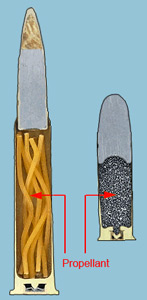- 01: Introduction
- 02: History
- 03: Propellants, Firearms, and Ammunition Development
- 04: Modern Firearms Manufacture
- 05: Small Arms Ammunition
- 06: Evidence Handling Procedures
- 07: Equipment and Instrumentation
- 08: Examination of Firearms
- 09: Cartridge and Shotshell Examination
- 10: Characterization and Evaluation of Fired Projectiles
- 11: Bullet Comparison and Identification
- 12: Gunshot Residue and Distance Determination
- 13: Toolmark Identification
- 14: Communicating Results
- Resources


Propellants
Home > Small Arms Ammunition > Components > Propellants

Ammunition components
Modern small arms propellants all share a common origin, nitrocellulose. Nitrocellulose carries the majority of the chemical energy used to propel a projectile from a gun barrel. It is the result of treating cellulose with nitric acid in the presence of sulfuric acid.
For decades, the preferred source of cellulose was cotton linters, a by-product of the processing of cotton. As synthetic fibers reduced the amount of cotton by-products produced, finely ground wood fibers replaced linters in nitrocellulose production.
The first step in propellant manufacture is to create a mass of nitrocellulose (cellulose nitrate). Linters or wood fibers are exposed to nitric acid; nitrate radicals replace some of the hydrogen molecules in cellulose, adding oxygen and energy to the reaction. To achieve the proper level of nitration, sulfuric acid is included to scavenge excess water so the maximum number of nitrate radicals can attach and preclude the reaction from coming to a halt.
The resulting mass of nitrocellulose must be sticky and relatively cohesive for further processing; a solvent must be incorporated into the mass to achieve these properties. Only certain chemicals act as nitrocellulose solvents. For single-base propellants, the mass is softened with a mixture of alcohol and ether, which adds practically no energy to the nitrocellulose.
For double-based propellants, nitroglycerin (NG) is used as a solvent. NG adds significant energy of its own, supplementing the nitrocellulose contribution. Although pure nitroglycerin is very dangerous to handle, mixing it with other materials, including nitrocellulose, controls its explosive nature.
Double-base propellants have a slight advantage over single-base varieties: NG is not very volatile, and therefore is very stable over time. The alcohol-ether solvent in single-base propellants is very volatile, and evaporation of the solvent can change the rate at which the propellant releases energy. Modern packaging and storage techniques have eliminated this problem. Materials like the alcohol-ether blend or NG are called plasticizers, and are mandatory for the way the nitrocellulose is subsequently processed. Once the nitrocellulose mass is made cohesive by the plasticizers, it is ready for the next step—extrusion. Before understanding extrusion, we need to understand the common shapes used in modern propellants.

Click here to view a slide show of the propellant manufacture process.




